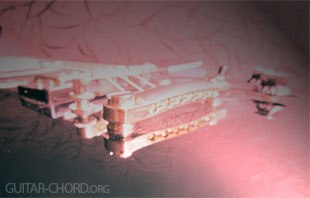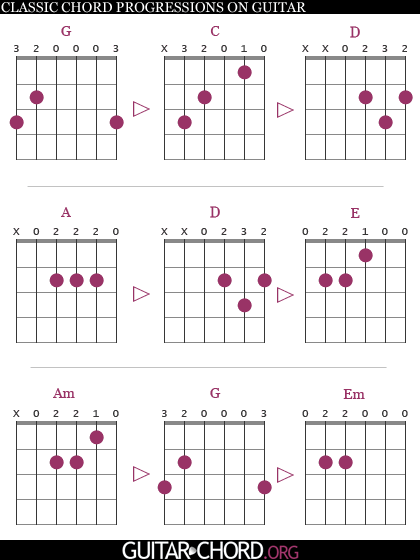Chords that sound good together
 You strum a chord … and where do you go next? This is a common question and we will try to sort out some answers.
You strum a chord … and where do you go next? This is a common question and we will try to sort out some answers.
Regardless which chord you start playing, the next you choose will sound all from just right to completely wrong. Here we focus on what sounds good. If you, for example, start with C it will never sound bad if you continue with F or G. Let’s do some organizing of chords and point out which fit nicely together.
Pair of chords
It's quite easy to find a pair of chords that fit together and it's enough to mention a few examples before we go on with longer progressions.
Am – Em
C – Fmaj7
G – Cadd9
You can play these pairs of chords in both directions. Am to Em or Em to Am works well in both cases.
Triples of chords
To learn which triples of chords that functions well together is really useful. Many riffs and choruses are constructed with only three chords. These triples of chords can be played in different orders, but the first letter make up the tonal center and establish the key.
C – F – G
D – G – A
E – A – B
F – Bb – C
G – C – D
A – D – E
B – E – F#
Note that all these triples have the same relationship in distances on the fretboard when you play barre chords and power chords.
Add a fourth (non-diatonic) chord
The categories listed above have all very distinct relations to each other. When you try to add a fourth major chord, it will not always sound absolutely right. The most common way is instead to incorporate minor chords, but before we come to that we will try to add a fourth, non-diatonic, major chord (i.e. not related to the scale), which in the right situations can be very well suited.
So if you wish to create longer progressions for your rock song riffs or whatever, here is a list with four-chord progressions that sound good together (non-diatonic chords in bold).
C – F – G – E
D – G – A – F#
G – B – C – D
E – A – B – G#
F – Bb – C – A
A – C# – D – E
B – E – F# – D#
Try these sequences both with open chords and barre/power chords.
Add another fourth (non-diatonic) chord
Far from all guitarists knows that it's possible to add yet another major chord which tones is partly outside the key. These chords are even far away from the key since its relative minor is not in the key as was the case above. Therefore, it will be more important where you put this second non-diatonic chord in sequences to make it sound great; otherwise, it could be too much dissonance.
Here are some sequences that include this non-diatonic chord (in bold) together with diatonic chords:
A – E – C – D
F – G# – Bb – C
D – F – G – A
G – Bb – C – D
You could include some minor chords as well, but these sequences were meant to show different possibilities for major chords exclusively, which for example could help you with power chord progressions. You can change the sequences from major to power chords, for example: A5 - E5 - C5 - D5.
Major and minor combined
In many occasions you want both major and minor in your progressions. Here is a list with chord groups that sound good and include both categories.
C – Em – F – Am
D – F#m – G – Bm
E – G#m – A – C#m
F – Am – Bb – Dm
G – Bm – C – Em
A – C#m – D – F#m
B – D#m – E – G#m
These four-parts groups are, among other things, great when creating verses in songs. You mustn't use all four in every progression, or in this particular order. Look at the groups as resources from which you can combine two, three or four chords together.
If you want to go more into depth, see the 500 Guitar Chord Progressions ebook.
Evergreens
Do you miss pictures on the chords? See the Illustrated Chord progression ebook or, if you feel lost, though, the image below may give you a jump start.

The image probably doesn’t need any explanation, but ... it shows three classic progressions: G - C - D, A - D - E and Am - G - Em.
A final comment
The groups have been based on regular major and minor chords. If you want to add some flavor, you can experiment by changing a regular major to a major seventh or a regular minor to a minor seventh. Additionally, you could include some sus chords, preferably in combination with or as substitute for a major chord.
Go to the section with chord progressions for more ideas.